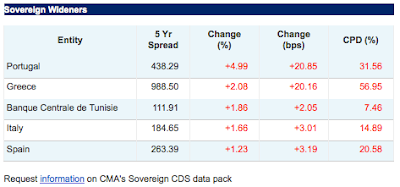“Despite Moody’s downgrade on Ireland’s credit rating on Monday, the NTMA successfully borrowed €1.5bn yesterday. Yesterday’s auction showed increased demand from investors for Irish debt and now means that the NTMA has completed 90% of its 2010 long-term borrowing programme.”
That was the swan song from one of Irish stock brokerages.
Lex column in the FT was far less upbeat, saying Ireland “offers a not terribly encouraging example of how difficult it is to overcome a massive debt binge.”
NTMA might have pre-borrowed 90% of this year’s €20bn borrowing target . But two things are coming to mind when one hears this ‘bullish’ statement.
Firstly, the €20bn is a target, not the hard requirement. If banks come for more cash, Brian Lenihan will have to get more bonds printed.
Secondly, Irish spread over German bunds is now higher than it was at the peak of the crisis in early 2009.
Want see some pictures illustrating Irish borrowing ‘success story’?
Let us start on the shorter end of maturity spectrum – 5 years and under:
Chart 1

Average yields are trending up over the entire crisis term and are soudly above their entire crisis trend line since June. More significantly, the trend is now broken. As yields declined in 2009, hitting bottom in October, since then, they have posted a firm reversion up and once again, June and July auctions came at yields above those for this dramatic sub-trend.
Worse than that – in complete refutation of ‘improved demand’ claim by the brokers – yield spreads are now elevated. This spread – the difference between highest yield allocated and lowest yield allocated – suggests that markets are having trouble calmly pricing Irish bonds issues. Success or psychosis?
Chart 2 below illustrates the same happening in terms of price spreads.
Chart 2

Auctions cover for shorter term paper is still below the long term trend line, although the line is positively sloped.
Chart 3

Chart 3 above shows just how dramatic was the price decline and yields rise in Q2 2010 and how this is continued to be the case in July.
Chart 4

Chart 4 gives a snapshot on pricing.
Next, move on to longer term bonds (10 years and over). There has been only one issue of 15 year bonds, so it is clear that the NTMA is simply unwilling to currently issue anything above 10 year horizon because of prohibitive yields.
Chart 5

Chart 5 above shows upward trend in yields and July relative underperformance compared to longer term trends. It also shows yield spreads – again posting some pretty impressive volatility in June and bang-on long-term average (or crisis-average) performance in July. If that’s the ‘good news’ I should join a circus.
Chart 6

Weighted average price is not changing much over the crisis period, so no improvement is happening here. In fact, since May it is trending down below the long term trend line, suggesting significant and persistent deterioration. Cover is on the up-trending line, but came in below the trend in June and July.
Chart 7 below shows more details on max and min prices and yields.
Chart 7

Chart 8

Chart 8 above clearly shows how average price is now in the new sub0trend pattern since November 09 price peak. May-July prices achieved are clearly below long term trend line and even more importantly – below the sub-trend line.
Finally, chart 9 shows the maturity profile of auctioned bonds:
Chart 9

Notice how before the 2014 deadline, the Exchequer is facing the need to roll over €6,381 million in bonds issued during the 2009-present auctions. If Ireland Inc were to issue more 3-year bonds, that number will rise. That should put some nasty spanners into Irish deficits-reduction machine. But hey, what’s to worry about – our kids will have to roll over some €21,264 million worth of our debts (and rising), assuming the Bearded Ones of Siptu/Ictu & Co don’t get their way into borrowing even more.
Let us summarize the ‘success story’ that our brokerage houses are keen on repeating:
Table 1

In other words, we are now worse off in terms of the cost of borrowing than in January 2010 – despite the ‘target’ for new issuance remaining the same throughout the period. We are even worse off now than at the peak of the crisis in March-April 2009 in short-term borrowing costs, although, courtesy of the German bund performance since then, we are only slightly better off in terms of longer maturity borrowings.
The compression in yield term structure delivered in June-July this year is worrisome as well. It suggests that the markets are not willing to assume that Irish Government longer term position is that much different from its shorter term prospects.
So on the net, then, what 'success' are our stock brokers talking about then? The success, of course is that NTMA was able to get someone pick up the phone and place an order, at pretty much any price? Next time, they should try selling pizzas alongside the bonds - the cover might rise again and they might convince the Eurostat that pizza delivery services are not part of the public deficit...
 Makes you wonder if Portugal, Italy and Spain bonds brokers have been pushing their clients into losses as hard as our own did...
Makes you wonder if Portugal, Italy and Spain bonds brokers have been pushing their clients into losses as hard as our own did...








































